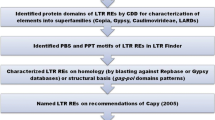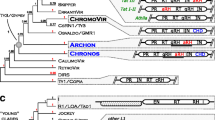Abstract
In this study, the reverse transcriptase sequences of Ty1-copia-like retrotransposons were amplified from ROC22 and Badila, and their characteristics, diversity, phylogenetic relationships and transcriptional activity were analyzed. The genomic DNA was amplified by PCR using degenerate primers. The targeted amplified bands in both varieties are all about 260 bp in size. Forty-four and thirty-eight sequences were isolated from ROC22 and Badila, respectively. The length of the former and the latter ranged from 233 to 263 bp and from 233 to 264 bp. The proportion of AT content in the former and in the latter ranged from 45.63 to 62.74% and from 50.58 to 65.40%. The ratio of AT to GC in the former and in the latter ranged from 0.84 to 1.68 and from 1.02 to 1.89. The similarity between nucleotide sequences in the former and in the latter ranged from 47.9 to 98.5% and from 42.3 to 98.8%. According to the cluster analysis, the former was divided into two families, of which family I was divided into five subfamilies. The latter was also divided into two families, of which family I was divided into six subfamilies and family II was divided into three subfamilies. Six of the former and fourteen of the latter had nonsense mutations. The nonsense mutations rate of the latter was much higher than that of the former. The similarity between amino acids in the former and in the latter ranged from 12.9 to 100% and from 42.3 to 98.8%, and the heterogeneity of the latter was lower than that of the former. There were differences in the length of main conserved motifs between the two varieties. The differences of protein structure in the Badila were greater than in the ROC22, and the structure of sequences in the Badila was more complex. The phylogenetic tree showed that all sugarcane reverse transcriptase sequences were divided into six classes. It was found that eleven sugarcane Ty1-copia-like retrotransposons had transcriptional activity. And the transcriptional activity of Ty1-copia-like retrotransposons in the ROC22 was higher than that of Ty1-copia-like retrotransposons in the Badila. The obtained sequences will provide sequences basis for isolating the full-length sequences of Ty1-copia-like retrotransposons, studying their transcriptional transposition activity and function, and laying the foundation for the development of molecular markers in sugarcane.











Similar content being viewed by others
References
Aljanabi, S.M., Y. Parmessur, H. Kross, S. Dhayan, S. Saumtally, K. Ramdoyal, L.J.C. Autrey, and A. Dookun-Saumtally. 2007. Identification of a major quantitative trait locus (QTL) for yellow spot (Mycovellosiella koepkei) disease resistance in sugarcane. Molecular Breeding 19 (1): 1–14.
Andru, S., Y.B. Pan, S. Thongthawee, D.M. Burner, and C.A. Kimbeng. 2011. Genetic analysis of the sugarcane (Saccharum spp.) cultivar ‘LCP 85–384’. I. Linkage mapping using AFLP, SSR, and TRAP markers. Theoretical and Applied Genetics 123: 77–93.
Bennetzen, J.L., and H. Wang. 2014. The contributions of transposable elements to the structure, function, and evolution of plant genomes. Annual Review of Plant Biology 65: 505–530.
Bonchev, G., and C. Parisod. 2013. Transposable elements and microevolutionary changes in natural populations. Molecular Ecology Resources 13 (5): 765–775.
Costet, L., L. Le Cunff, S. Royaert, L.M. Raboin, C. Hervouet, L. Toubi, H. Telismart, O. Garsmeur, Y. Rousselle, J. Pauquet, S. Nibouche, J.C. Glaszmann, J.Y. Hoarau, and A. D’Hont. 2012. Haplotype structure around Bru1 reveals a narrow genetic basis for brown rust resistance in modern sugarcane cultivars. Theoretical and Applied Genetics 125 (5): 825–836.
De Araujo Paula, G., M. Rossi, E.M. de Jesus Jr, N.L. Saccaro, D. Kajihara, R. Massa, J.M. de Felix, R.D. Drummond, M.C. Falco, S.M. Chabregas, E.C. Ulian, M. Menossi, and M.A. Van Sluys. 2005. Transcriptionally active transposable elements in recent hybrid sugarcane. The Plant Journal 44 (5): 707–7171.
De Jesus, E.M., E.A. Ochoa Cruz, G.M.Q. Cruz, and M.A. Van Sluys. 2012. Diversification of hAT transposase paralogues in the sugarcane genome. Molecular Genetics and Genomics 287 (3): 205–219.
Diao, X.M., M. Freeling, and D. Lish. 2006. Horizontal transfer of a plant transposon. PLoS Biology 4 (1): 120–128.
Doolittle, R.F., D.F. Feng, M.S. Johnson, and M.A. McClure. 1989. Origins and evolutionary relationships of retroviruses. Quarterly Review of Biology 64 (1): 1–30.
Feschotte, C., N. Jiang, and S.R. Wessler. 2002. Plant transposable elements: Where genetics meets genomics. Nature Reviews Genetics 3 (5): 329–341.
Flavell, A.J., M.R. Knox, S.R. Pearce, and T.H.N. Ellis. 1998. Retrotransposon-based insertion polymorphisms (RBIP) for high throughput marker analysis. The Plant Journal 16 (5): 643–650.
Gabriel, A., M. Willems, E.H. Mules, and J.D. Boeke. 1996. Replication infidelity during a single cycle of Ty1 retrotransposition. Proceedings of the National Academy of Sciences of the United States of America 93 (15): 7767–7771.
Glynn, N.C., C. Laborde, R.W. Davidson, M.S. Irey, B. Glaz, A. D’Hont, and J.C. Comstock. 2013. Utilization of a major brown rust resistance gene in sugarcane breeding. Molecular Breeding 31 (2): 323–331.
Heslop-Harrison, J.S., A. Brandes, S. Taketa, T. Schmidt, A.V. Vershinin, E.G. Alkimova, A. Kamm, R.L. Doudrick, T. Schwarzacher, A. Katsiotis, S. Kubis, A. Kumar, S.R. Pearch, A.J. Flavell, and G.E. Harrison. 1997. The chromosomal distributions of Ty1-copia group retrotransposable elements in higher plants and their implication for genome evolution. Genetica 100: 197–204.
Huang, D.L., Y.J. Gao, Y.Y. Gui, Z.L. Chen, C.X. Qin, M. Wang, Q. Liao, L.T. Yang, and Y.R. Li. 2016. Transcriptome of high-sucrose sugarcane variety GT35. Sugar Tech 18 (5): 520–528.
Kalendar, R., T. Grob, M. Regina, A. Suoniemi, and A. Schulman. 1999. IRAP and REMAP: Two new retrotransposon-based DNA fingerprinting techniques. Theoretical and Applied Genetics 98 (5): 704–711.
Kumar, A. 1998. The evolution of plant retroviruses: Moving to green pastures. Plant Science 3 (10): 371–374.
Kumar, A., and J.L. Bennetzen. 1999. Plant retrotransposons. Annual Review of GenEtics 33: 479–532.
Kumar, A., S.R. Pearce, K. McLean, G. Harrison, J.S. Heslop-Harrison, R. Waugh, and A.J. Flavell. 1997. The Tyl-copia group of retrotransposons in plants: Genomic organisation, evolution and use as molecular markers. Genetica 100: 205–217.
Kumekawa, N., E. Ohtsubo, and H. Ohtsubo. 1999. Identification and phylogenetic analysis of gypsy-type retrotransposons in the plant kingdom. Genes & Genetic Systems 74 (6): 299–307.
Li, W.F., X.Y. Wang, Y.K. Huang, R.Y. Zhang, H.L. Shan, J. Yin, and Z.M. Luo. 2017. Molecular detection of Bru1 gene and identification of brown rust resistance in Chinese sugarcane germplasm. Sugar Tech 19 (2): 183–190.
Liao, S.T., W. Xian, H. Zhou, Q. Liang, Y.Y. Gui, and R.Z. Yang. 2012. Assessment of cold tolerance in different sugarcane varieties using SRAP markers. Southwest China Journal of Agricultural Sciences 25 (4): 1171–1176.
Liu, J.X., F.Q. Xiong, J. Liu, L. Luo, L.H. Qiu, L.M. Liu, J.M. Wu, H.J. Liu, X. Liu, M.M. Lu, Y.B. He, and S. Li. 2019. High quality sugarcane DNA extraction methods for cloning and molecular marker analysis. Molecular Plant Breeding 17 (2): 545–552.
Liu, X.L., J. Mao, X. Lu, L. Ma, K.S. Aitken, P.A. Jackson, Q. Cai, and Y.H. Fan. 2010. Construction of molecular genetic linkage map of sugarcane based on SSR and AFLP markers. Acta Agronomica Sinica 36 (1): 177–183.
Liu, X.L., X.J. Li, H.B. Liu, L. Ma, C.H. Xu, and Y.H. Fan. 2015. Genetic diversity analysis of Yunnan commonly-used parents by using SSR marker. Journal of Plant Genetic Resources 16 (6): 1214–1222.
Nakayama, S. 2012. Inter-MITE polymorphisms of a newly identified MITE show relationships among sugarcane (Saccharum) species. Genetic Resources and Crop Evolution 59 (7): 1389–1396.
Neuber, A.C., F.R.C. Santos, J.B. Costa, M. Volpin, M.A. Xavier, D. Perecin, R.C.V. Burbano, M.G.A. Landell, and L.R. Pinto. 2017. Survey of the Bru1 gene for brown rust resistance in Brazilian local and basic sugarcane germplasm. Plant Breeding 136 (2): 182–187.
Ostertag, E.M., B.B. Madison, and H. Kano. 2007. Mutagenesis in rodents using the LI retrotransposon. Genome Biology 8 (S1): S16.
Parco, A.S., M.C. Avellaneda, A.H. Hale, J.W. Hoy, C.A. Kimbeng, M.J. Pontif, K.A. Gravois, and N. Baisakh. 2014. Frequency and distribution of the brown rust resistance gene Bru1 and implications for the Louisiana sugarcane breeding programme. Plant Breeding 133 (5): 654–659.
Que, Y.X., Y.B. Pan, Y.H. Lu, C. Yang, Y.T. Yang, N. Huang, and L.P. Xu. 2014. Genetic analysis of diversity within a Chinese local sugarcane germplasm based on start codon targeted polymorphism. BioMed Research International 2014: 1–10.
Racedo, J., M.F. Perera, R. Bertani, C. Funes, V. González, M.I. Cuenya, A. D’Hont, B. Welin, and A.P. Castagnaro. 2013. Bru1 gene and potential alternative sources of resistance to sugarcane brown rust disease. Euphytica 191 (3): 429–436.
Raza, S., S. Anjum, S. Qamarunisa, I. Jamil, A. Azhar, and J.A. Qureshi. 2011. Genome analysis of sugarcane (cultivar BL4) to investigate transposable elements. Pakistan Journal of Biochemistry and Molecular Biology 44 (2): 68–72.
Rossi, M., P.G. Araujo, E.M. de Jesus, A.M. Varani, and M.A. Van Sluys. 2004. Comparative analysis of Mutator-like transposases in sugarcane. Molecular Genetics and Genomics 272 (2): 194–203.
Rossi, M., P.G. Araujo, and M.A. Van Sluys. 2001. Survey of transposable elements in sugarcane expressed sequence tags (ESTs). Genetics and Molecular Biology 24 (1–4): 147–154.
Song, Y., D. Ji, S. Li, P. Wang, Q. Li, and F. Xiang. 2012. The dynamic changes of DNA methylation and histone modifications of salt responsive transcription factor genes in soybean. PLoS ONE 7 (7): e41274.
Steinhauer, D.A., and J.J. Holland. 1986. Direct method for quantitation of extreme polymerase error frequencies at selected single base sites in viral RNA. Journal of Virology 57 (1): 219–228.
Tang, Y.M., Y.Z. Ma, L.C. Li, and X.G. Ye. 2005. Identification and characterization of reverse transcriptase domain of transcriptionally active retrotransposons in wheat genomes. Journal of Integrative Plant Biology 47 (5): 604–612.
Voytas, D.F., M.P. Cummings, A. Konieczny, F.M. Ausubel, and S.R. Rodermel. 1992. Copia-like retrotransposons are ubiquitous among plants. Proceedings of the National Academy of Sciences of the United States of America 89 (15): 7124–7128.
Wang, Y., N.S. Zhuang, D.Y. Huang, H.Q. Gao, and W.Q. Wu. 2009. Sequence characterized amplified region (SCAR) translation analysis of the RAPD markers in sugarcane parental germplasm. Journal of Agricultural Biotechnology 17 (4): 713–121.
Waugh, R., K. McLean, A.J. Flavell, S.R. Pearce, A. Kumar, B.B.T. Thomas, and W. Powell. 1997. Genetic distribution of Bare-1-like retrotransposable elements in the barley genome revealed by sequence-specific amplification polymorphisms (S-SAP). Molecular and General Genetics 253 (6): 687–694.
Wu, Z.Y., S. Yang, W. Qian, J.Y. Wu, K. Chen, K. Zhang, P.T. Li, and Z.H. Deng. 2020. Cloning and characterisation of reverse transcriptase sequences of Ty1-copia retrotransposon in Saccharum robustum. Journal of Plant Genetic Resources 21 (2): 466–476.
Yu, A.L., M.Q. Zhang, and R.K. Chen. 2002. Applicability of inter-simple sequence repeat polymorphisms in sugarcane and its related genera as DNA markers. Journal of Fujian Agriculture and Forestry University (natural Science Edition) 31 (4): 484–489.
Zhang, J.S., A. Sharma, Q.Y. Yu, J.P. Wang, L.T. Li, L. Zhu, X.T. Zhang, Y.Q. Chen, and R. Ming. 2016. Comparative structural analysis of Bru1 region homeologs in Saccharum spontaneum and S. officinarum. BMC Genomics 17: 446.
Zhang, J.S., X.T. Zhang, H.B. Tang, et al. 2018. Allele-defined genome of the autopolyploid sugarcane Saccharum spontaneum L. Nature Genetics 50 (11): 1565–1573.
Zan, F.G., X.M. Ying, C.W. Wu, P.F. Zhao, X.K. Chen, L. Ma, H.S. Su, and J.Y. Liu. 2015. Genetic diversity analysis of 98 collections of sugarcane germplasm with AFLP markers. Scientia Agricultura Sinica 48 (5): 1002–1010.
Acknowledgements
This study was financed by the National Natural Science Foundation of China (31960416; 31960409; 31660428; 81860678), Guangxi Natural Science Foundation Program (2018GXNSFDA294004; 2018GXNSFDA281027; 2020GXNSFAA297081) and Guangxi Academy of Agricultural Sciences Fund Project (GNK31960416; GNK31960409; GNK2017JZ13; GNK2018YM06).
Author information
Authors and Affiliations
Corresponding author
Ethics declarations
Conflict of interest
The authors declare that they have no conflict of interest.
Additional information
Publisher's Note
Springer Nature remains neutral with regard to jurisdictional claims in published maps and institutional affiliations.
Rights and permissions
About this article
Cite this article
Liu, JX., Liu, J., Yang, TY. et al. Isolation and Analysis of Reverse Transcriptase of Ty1-copia-Like Retrotransposons in Sugarcane. Sugar Tech 24, 1510–1529 (2022). https://doi.org/10.1007/s12355-021-01063-6
Received:
Accepted:
Published:
Issue Date:
DOI: https://doi.org/10.1007/s12355-021-01063-6




